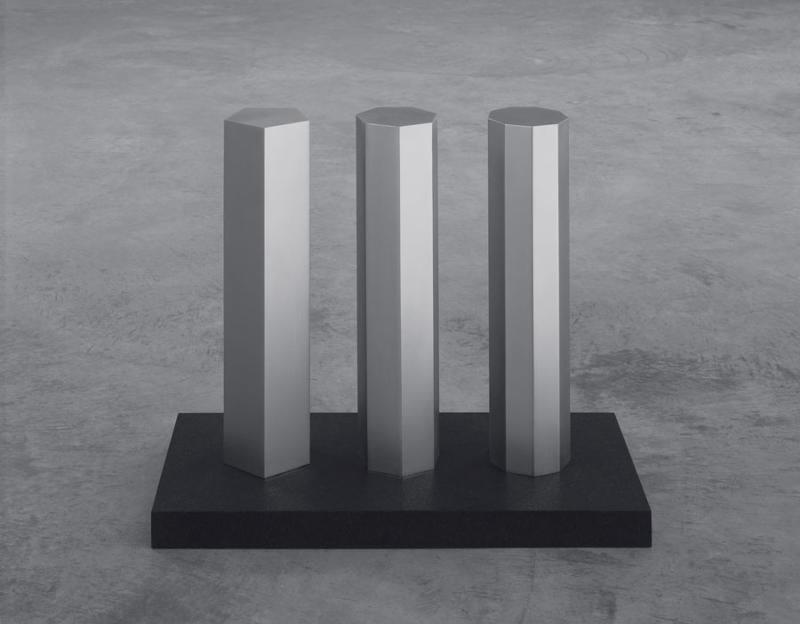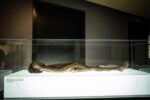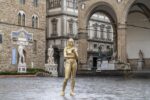Walter De Maria – The 5-7-9 Series

Le tre opere esposte, The 5-7-9 Series (1992), Large Rod Series: Circle/Rectangle 11 (1986), The 13-Sided Open Polygon (1984), rappresentano ognuna una importante serie nell’opera di De Maria degli ultimi cinquanta anni. Pur presentando progressioni geometriche e numeriche, tali lavori combinano austere progressioni matematiche alle più intangibili qualità del sublime.
Comunicato stampa
[Scroll down for Italian version / Testo in italiano al termine della versione in inglese]
Gagosian Gallery is pleased to announce an exhibition of important sculpture by Walter De Maria. Each of the three works on view, The 5-7-9 Series (1992), the Large Rod Series: Circle/Rectangle 11 (1986), and The 13-Sided Open Polygon (1984), represents a major series for De Maria during the last fifty years. Although the works engage geometric and numerical progression, they balance stark mathematical fact with the more intangible qualities of the sublime.
The 5-7-9 Series is the second of three related, large-scale 27-part installation sculptures. The Rome presentation is edition 2/2; the first edition is on permanent view at the Gemäldegalerie, Berlin. The work is preceded by The 4-6-8 Series (1966) and followed by Time/Timeless/No Time (2004, from the 3-4-5 Series), on permanent view at the Chichu Art Museum, Naoshima Island, Japan. All works in each series consist of 27 unique sculptural variations, each made of three vertical rods affixed to a horizontal base.
Each of the shaped solid stainless steel rods in The 5-7-9 Series has five, seven, or nine sides, and the order of these three rods is presented in 27 unique presentations. Every possible combination of vertical elements is realized. The installation of the sculptures is then determined by the given site, as they are often arranged in single or triple rows, and they may be ordered in a nearly infinite number of ways. In Rome, their arrangement will complement the oval shape of the main gallery, with a display of three rows of nine works. The vertical rod is an element that has recurred throughout De Maria's oeuvre, with one of the earliest examples being Bed of Spikes (1968-69). This was followed by the outdoor installation, The Lightning Field (1977), in New Mexico. A large-scale photograph opens the exhibition, depicting this icon of land art against the panorama of the Western American landscape.
In counterpoint to the vertical structure of The 5-7-9 Series are two stainless steel floor sculptures: Large Rod Series: Circle/Rectangle 11 and 13-Sided Open Polygon. Both are displayed in their own gallery spaces. Circle/Rectangle 11 consists of eleven eleven-sided rods. In Rome the work is displayed in a rectangular configuration, although displaying the eleven rods in a circular pattern is also an option. The eleven large rods share an affinity to the rows that form the 500-part Broken Kilometer (1979). The 13-Sided Open Polygon comes from a series of polygonal floor sculptures whose form ranges from five to seventeen sides. These works were created by the artist between 1973 and 1984. Within the stainless steel circumference of each polygon sits a solid stainless steel ball whose many movements are confined by the limits of the interior track, emphasizing the artful combination of order and randomness that pervades De Maria's work.
On the occasion of this exhibition, the original exhibition catalogue for The 5-7-9 Series published by Gagosian Gallery in 1992 will be reprinted and expanded, including a text by Lars Nittve.
Walter De Maria was born in 1935 in California and has lived and worked in New York since 1960. He has been an important force within four major art historical movements during the twentieth century: Minimalism, conceptual art, land art, and installation art. De Maria has exhibited his work throughout the world, and his eight solo museum exhibitions include those at the Menil Museum, Houston (2011-12); Chichu Art Museum, Naoshima, Japan (2000, 2004); Fondazione Prada, Milan (1999); and the Kunsthaus Zürich (1992, 1999). Among the eleven permanent, commissioned sculptures by the artist are The New York Earth Room (1977), New York; The Broken Kilometer (1979), New York; The Lightning Field (1977), New Mexico; The Vertical Earth Kilometer (1977), Kassel, Germany; Monument to the Bicentennial of the French Revolution 1789-1989 (1989-90), Assemblée Nationale, Paris; and the Large Red Sphere (2010), in the Türkentor building, Munich.
Press Enquiries
Francesca Martinotti
T. +39.06.9784.8570
www.francescamartinotti.com
For all other information please contact the gallery at +39.06.4208.6498 or at [email protected].
----------
Inaugurazione alla presenza dell'artista: giovedì 22 marzo, dalle ore 18 alle 20
Gagosian Gallery è lieta di annunciare una mostra di sculture di Walter De Maria.
Le tre opere esposte, The 5-7-9 Series (1992), Large Rod Series: Circle/Rectangle 11 (1986), The 13-Sided Open Polygon (1984), rappresentano ognuna una importante serie nell'opera di De Maria degli ultimi cinquanta anni. Pur presentando progressioni geometriche e numeriche, tali lavori combinano austere progressioni matematiche alle più intangibili qualità del sublime.
The 5-7-9 Series (1992), esposta a Roma, fa parte di una serie di tre imponenti installazioni composte da 27 elementi. Come The 4-6-8 Series (1966) e Time/Timeless/No Time (2004, facente parte della 3-4-5 Series ed in esposizione permanente presso Chichu Art Museum di Naoshima Island in Giappone), questa presenta 27 variazioni di sculture uniche, ognuna composta da tre barre verticali inserite su una base orizzontale. L'altra edizione di The 5-7-9 Series è in esposizione permanente presso la Gemäldegalerie di Berlino.
Ognuna delle barre di acciaio massiccio che compongono The 5-7-9 Series presenta cinque, sette o nove lati e l'ordine di ciascun gruppo di tre viene ripetuto in 27 modi diversi. Tutte le combinazioni possibili sono così realizzate. L'allestimento delle sculture è determinato dallo spazio che le ospita; possono venir infatti presentate in file singole o triple, con modalità quasi illimitate. A Roma l'installazione dialoga con la sala espositiva ovale presentandosi in tre file di nove elementi. La barra verticale è un motivo ricorrente nell'arte di De Maria, come esemplificato già in una delle prime opere-Bed of Spikes (1968-69) e confermato dalla iconica installazione permanente di Arte Ambientale The Lightning Field(1977) in New Mexico, di cui la mostra romana presenta una riproduzione fotografica di grande formato.
In contrapposizione alla verticalità di The 5-7-9 Series, due sculture in acciaio, Large Rod Series: Circle/Rectangle 11e13-Sided Open Polygon, sono allestite in due spazi espositivi separati. Circle/Rectangle 11 è composta da undici barre di undici lati ciascuna. L'opera è esposta con una configurazione rettangolare, sebbene la presentazione degli undici elementi in maniera circolare possa costituire una possibile alternativa. Le undici barre evocano i cinquecento elementi di un'altra installazione permanente: il Broken Kilometer(1979) visibile a New York. The 13-Sided Open Polygon si inserisce invece nella serie di sculture poligonali da terra le cui forme variano da cinque a diciassette lati, realizzate tra il 1973 e il 1984: all'interno della scultura poligonale è posizionata una sfera di acciaio i cui molteplici movimenti sono confinati nei limiti del prestabilito percorso interno, enfatizzando così l'astuta combinazione di ordine e casualità, elementi distintivi dell'opera di De Maria.
La mostra è accompagnata dalla riedizione-con ampliamenti e traduzione in italiano del saggio di Lars Nittve-del catalogo pubblicato da Gagosian Gallery nel 1992 in occasione della presentazione al pubblico di The 5-7-9 Series.
Walter De Maria è nato nel 1935 in California edal 1960 vive e lavora a New York. E' stato una figura fondamentale all'interno di quattro importanti movimenti artistici: Minimalismo, Arte Concettuale, Arte Ambientale, Installation Art. I lavori di De Maria sono presenti in tutto il mondo; le sue otto personali museali includono Menil Museum, Houston (2011-12); Chichu Art Museum, Naoshima, Giappome (2000, 2004); Fondazione Prada, Milano (1999); the Kunsthaus Zurigo (1992, 1999). Tra le undici opere permanenti eseguite dall'artista su commissione si annoveranoThe New York Earth Room(1977), New York;The Broken Kilometer(1979), New York; The Lightning Field (1977), New Mexico;The Vertical Earth Kilometer(1977), Kassel, Germania;Monument to the Bicentennial of the French Revolution 1789-1989(1989-90), Assemblée Nationale, Parigi e Large Red Sphere(2010), nel Türkentor a Monaco.



